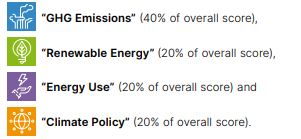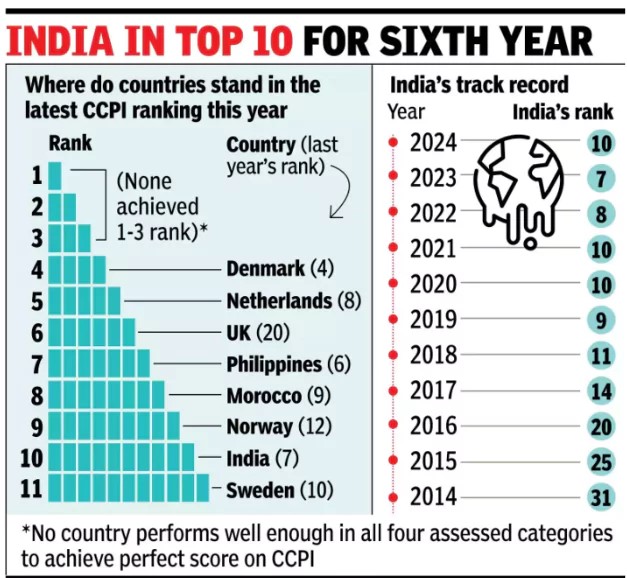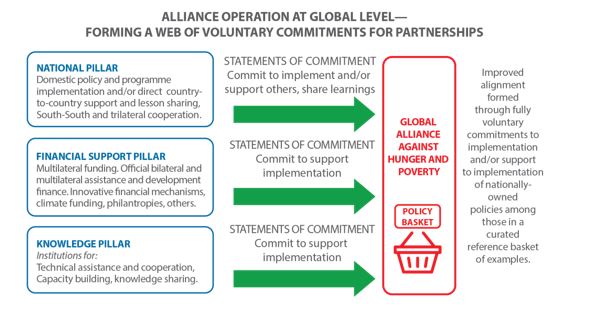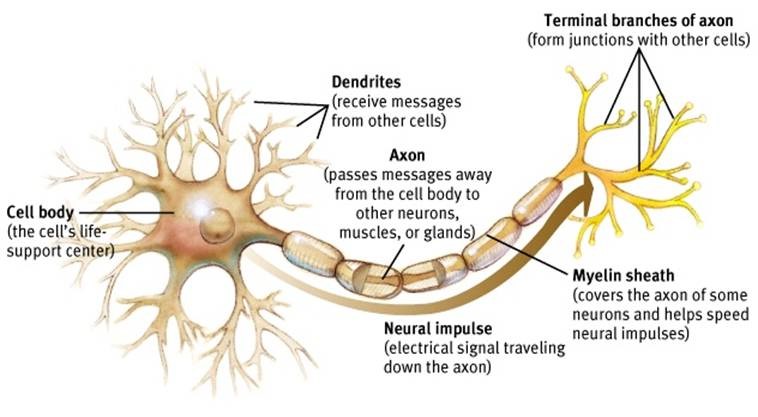Climate Change Performance Index (CCPI), 2025
Recently, the United Nations Climate Change Conference (UNCCC) released a report of Climate Change Performance Index (CCPI) 2025 in Baku, Azerbaijan.
- CCPI - It is an independent monitoring tool released annually for tracking countries climate mitigation performance.
- Aim - It increases transparency in national and international climate policy and enables comparison of individual countries climate protection efforts and progress.
- Published by - Germanwatch, New Climate Institute, and Climate Action Network International.
- The CCPI was 1st presented at the 11th Meeting of the Conference of the Parties (COP 11) climate change conference in Montreal in 2005.
- Methodology – It evaluates and compares the climate protection performance of 63 countries and the European Union (EU).
- Together, these countries account for more than 90% of global greenhouse gas (GHG) emissions.
- Other countries with significantly lower emissions therefore are not applicable to the CCPI’s methodology.
- However, in the past years new countries have regularly been included (Nigeria, Pakistan, UAE and Uzbekistan were added in CCPI 2024).
- It uses production-based emissions only for its calculation.
- Indicators - 14
- Categories - 4

- 80% of the assessment is based on quantitative data from internationally recognised institutions.
- Top Ranking Countries, 2025 - The first 3 places empty, as no country performed well enough across all index categories to achieve an overall “very high” rating.
- Denmark (4th)
- Netherland (5th)
- UK (6th)
- Low Ranking Countries - Largest two emitters, China and the U.S., remain very low at 55th and 57th place, respectively.
- Iran (67th), Saudi Arabia (66th), the United Arab Emirates (65th), and Russia (64th).
- Only 22 of the 64 surveyed CCPI countries aligned with the 2015 Paris Agreement goal of keeping global temperature rise within 2 degrees Celsius and make efforts to contain it to 1.5 degrees.
- Methodology,2025 – It is based on the methodological design introduced in 2017 covering
- All greenhouse gas (GHG) emissions and
- Evaluates the 2030 targets and
- The well-below-2°C compatibility of countries’ current levels and targets in the categories

- India’s Rank - India ranks 10th out of the 63 countries.
- India drops 2 places but remains among top 10 climate performers.
- India's per capita emissions stand at 2.9 tons of CO2 equivalent (tCO2e), far below the global average of 6.6 tCO2e.
- Category ranking of India
- High - GHG Emissions and Energy Use
- Medium – Climate Policy
- Low - Renewable Energy
India has pledged to reach net zero emissions (balancing emissions with removals) by 2070 and aims to achieve 500 gigawatts of renewable energy capacity by 2030.
References
- The Hindu| Climate Change Performance Index (CCPI) 2025
- CCPI| Climate Change Performance Index (CCPI) 2025
Global Alliance against Hunger and Poverty
Recently, the G20 Leaders’ Summit launched an initiative Global Alliance against Hunger and Poverty in Rio de Janeiro, Brazil.
- It is a voluntary coalition leveraging UN bodies and other organizations for its operations, without having itself a legal personality. The Alliance is conceived as a country-driven initiative.
- Aim – To support and accelerate efforts to eradicate hunger and poverty (SDGs 1 and 2) while reducing inequalities (SDG 10) by 2030.
- 3 Pillars
- National – Coordination of specific public policies.
- Financial – Large-scale resource mobilization.
- Knowledge – Integration of data and technologies for evidence-based solutions.

Currently 622 million people will live below the extreme poverty line of $ 2.15 per day by 2030.
- Need - In 2015, all 193 UN Member States adopted the ‘2030 Agenda for Sustainable Development’.
- Aim - To end poverty and hunger, and achieve food security and improved nutrition by 2030.
- Policy Basket – It draws from Brazil’s experience and other best practices and approaches.
- Types - Policies and programs that are included by objective criteria:
- Well-defined policy instruments, with a clear scope
- Implemented/implementable by governments
- Evidence-based
- Primarily reaching out to people persons experiencing poverty and hunger
- Contributing primarily to reach Sustainable Development Goals 1 and 2.
- Commitments
- 500 million people through income support programs by 2030.
- Provide school meals to 150 million children in countries with high child hunger rates.
- Effective Mobilization of billions of dollars through multilateral banks for anti-poverty programs.
- Countries can join the Alliance by submitting a Statement of Commitment detailing how a state plans to support the initiative.
Statements of Commitment is mean to express a robust declaration of intent by the Alliance’s members, acting as a catalyst of positive change. They are not legally binding.
- Joined Members - 81 countries (including India), 26 international organisations, 9 financial institutions, and 31 philanthropic foundations and non-governmental organisations.
- Funding - The $2-3 million required annually for its operations will come from member countries and institutions such as the Food and Agriculture Organization (FAO), UNICEF, and the World Bank.
- The Alliance may be headquartered in Brasilia, or some other Global South country. It will also likely have an office at the FAO headquarters in Rome.
References
- Indian Express| Global Alliance against Hunger and Poverty
- GAAHP| Global Alliance against Hunger and Poverty
- G20| Global Alliance against Hunger and Poverty
Dendrites
Recently, the Scientists have first time uncovered a unique type of electrical signal from dendrites in the human brain.
- Dendrites – It is branch like extensions at the beginning of a neuron that help increase the surface area of the cell body.
- Characteristics – They are short, narrow and highly branched.
- The length of dendrites is about two μm, and they are usually 5 to 7 in numbers.
- Dendrites comprise various cytoskeletal structures, the Golgi apparatus, ribosomes, and smooth endoplasmic reticulum.
- Functions – Its primary job is to collect signals from other neurons and pass them to the neuron's main body, called the Soma.
- Dendrites also accumulate all incoming information from axon terminals.
- Dendrites collect messages from other neurons, which are then forwarded to the brain.
- The brain, then, sends back the instructions to various parts of the body so that a reaction can happen.
- Dendrites also have a significant role to play in psychological processes such as memory formation.

Recent Findings
- Researchers examined layer 2/3 (L2/3) pyramidal neurons from human brain tissue, specifically from the cerebral cortex, which plays a key role in advanced thinking and problem-solving.
- Calcium-Mediated Dendritic Action Potentials (dCaAPs) - They have uncovered for the 1st time a unique type of electrical signal in the human brain called dCaAPs.
- It showed a "graded" response which means their strength varied depending on the level of stimulation, they reached their peak at just the right level of input but became weaker with stronger inputs.
- These dendritic signals allow individual neurons to solve problems that scientists previously thought required entire networks of brain cells.
- Essentially, a single neuron can classify inputs that are traditionally seen as too complex for one cell to handle, redefining our understanding of brain computation.
Reference
India Today| Dendrites
Tuna fish
The Department of Fisheries has notified the Development of Tuna Cluster in the Andaman and Nicobar Islands under the Pradhan Mantri Matsya Sampada Yojana (PMMSY).
Andaman and Nicobar Islands offers 6.0 lakh square km of Exclusive Economic Zone (EEZ) rich in under-exploited sea resources, particularly Tuna and Tuna like high valued species, estimated at 60,000 metric tons.
- It is a saltwater fish that belongs to the tribe Thunnini.
- It comprises 15 species. Of those, 8 are considered “true tunas’, 5 species of bluefins and 3 species of yellowfins, all which belong to the genus Thunnus.
- Scientific name – Thunnus.
- Family – Scombridae.
- Size - Ranging from moderate (1.6 ft) to very large in size (15 ft).
- Appearance - Tunas are known for their sleek, torpedo-shaped bodies designed for speed and endurance.
- Tunas have crescent moon-shaped tails and two dorsal fins on their backs, one of which can be flattened to reduce resistance in the water.
The Atlantic bluefin tuna can swim up to 43 miles per hour and the yellowfin can swim even faster.
- Unique feature – They’re among the only partially warm-blooded fish on Earth.
- It has a well-developed network of blood vessels below the skin.
- This vascular system maintain the temperature of their bodies above that of the surrounding water.
- Habitat - Tunas are pelagic fish, meaning they live beyond the continental shelf in the open sea, not near coral reefs, the sea floor, or shoreline.
- Distribution – Found in tropical, temperate, even some cooler waters and worldwide.
- Diet - Tunas are apex predators, feed on fishes, squid, shellfish, and a variety of planktonic organisms.
- Breeding – Female lay eggs in the open sea over very large areas.
- Conservation Status – IUCN - Least Concern.
- Threats – Overfishing for both commercial and great value as food.
World Tuna Day is observed every year on 2nd of May.
|
Pradhan Mantri Matsya Sampada Yojana (PMMSY)
|
- PMMSY - It is a flagship scheme for focused and sustainable development of fisheries sector.
- Aim - To double the income of fish farmers and fishers in the country and to bring about Blue Revolution.
- Launched in - 2020.
- The PMMSY is an umbrella scheme with 2 separate Components namely
- Central Sector Scheme (CS) and
- Centrally Sponsored Scheme (CSS).
- PMMSY is implemented in all the States and Union Territories for a period of 5 years from 2020-21 to 2024-25.
|
Reference
PIB | Tuna Cluster in Andaman and Nicobar Islands
Phytoplankton Bloom
The researchers found drought in southern Africa’s drylands had caused the strongest phytoplankton bloom in about 27 years in the South East of Madagascar.
- Phytoplankton – It is a microalgae similar to terrestrial plants which contain chlorophyll and require sunlight in order to live and grow.
- Its growth depends on the availability of carbon dioxide, sunlight, and nutrients.
- It require inorganic nutrients such as nitrates, phosphates, and sulphur which they convert into proteins, fats, and carbohydrates.
- It float in the upper part of the ocean, where sunlight penetrates the water.
- Factors - Influence phytoplankton growth rates, including water temperature and salinity, water depth, wind, and kinds of predators are grazing on them.
- Main classifications
- Dinoflagellates – It use a whip-like tail, or flagella, to move through the water and their bodies are covered with complex shells.
- Diatoms – It have shells and their structure is rigid, made of interlocking parts, rely on ocean currents to travel through the water.
- It provide food for a wide range of sea creatures like zooplankton, shrimp, snails, jellyfish, and small fish to whales.
- Phytoplankton Bloom – Its takes place when a species of phytoplankton reproduces at a rapid rate, multiplying quickly in a short amount of time.
- It also form Harmful Algal Blooms (HABs).
HABs can produce extremely toxic compounds that have harmful effects on fish, shellfish, mammals, birds, and even people.
- High concentrations of bloom in the water column can cause the water to appear blue-green, green, brown or even red, depending upon the pigments found in the species experiencing the bloom.
- It may cover hundreds of square kilometers in the ocean and are easily visible in satellite images.
Recent Findings
- The researchers found that bloom was caused by nutrient rich dust like iron, nitrogen, and phosphorus that blew from drought drylands in the western parts of southern Africa.
- Major suppliers of dust to the Southern Ocean and its outer edges are
- Etosha and Makgadikgadi salt pans in Namibia and Botswana,
- Pans and ephemeral rivers in the coastal Namibian desert, and
- South-western Kalahari pan belt
- It carried over long distances by wind and deposited into the nutrient limited surface waters through intense rainfall events.
- Blooms of this magnitude are rare but rising air temperatures, increasing dryness, and higher dust emissions cause such events.
- This abundant food supply could have potentially boosted populations of zooplankton and fish species in the Madagascar region.
- The oceans absorbing carbon dioxide from the atmosphere, making them essential for climate regulation.
- The region acted as a significant carbon sink because of the high rates of photosynthesis occurred.
References
- Down to Earth| Phytoplankton Bloom
- NOS| Phytoplankton Bloom
- NASA| Phytoplankton Bloom


